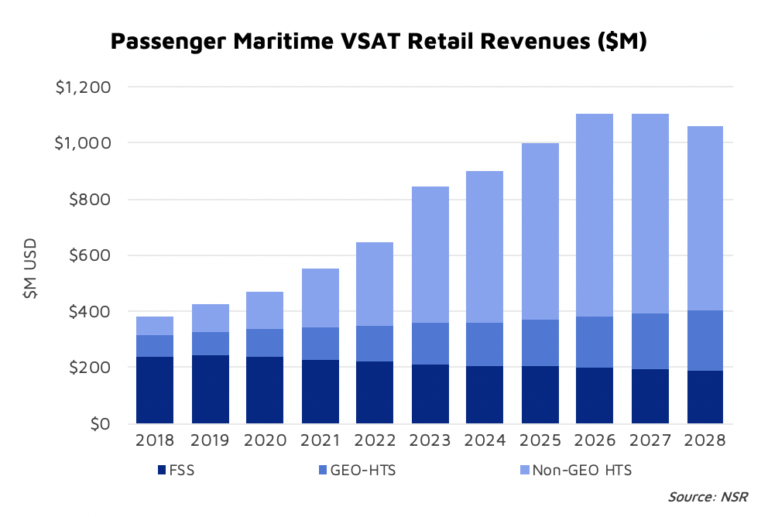|
Cruising to Higher Bandwidth
June 20, 2019 by Brad Grady | NSR
Do you have Children? An internet addicted spouse? Are
you yourself an ‘always-on’ IP-addict? Thinking about a
‘vacation at sea’? Gone are the days of leaving your
connected-lifestyle behind. Today, the passenger
maritime segment is one of the best-connected
satellite-enabled end-users around. With record-breaking
throughputs in the news over the last 12 months, the
passenger maritime sector continues to provision vessels
with higher and higher data rates.

In NSR’s
Maritime Satcom Markets, 7th
Edition
report, passenger vessels are projected to consume
upwards of 900 Gbps of satellite bandwidth by 2028 – up
from 35 Gbps in 2018. Spread over around 1,000 VSAT
vessels today, and 2,400 VSAT vessels by 2028, the
Mbps-per-vessel average will see a more than 10x jump
over the next ten-years. Driven mostly by the Caribbean
and Mediterranean, and especially high provisioning on
the largest passenger vessels, solving these highly
concentrated, high-bandwidth demand will be a key
challenge for the satellite sector.
One solution? Non-GEO HTS. This connectivity will be a
key enabling technology in this sector. Today, SES’s
MEO-HTS solution provides that connectivity, with a
migration towards mPower on the horizon. Beyond that,
all of the constellation providers have either formally
announced places to target Maritime or will almost
certainly include it amongst their ‘most desirable
vertical markets’. At over $1B in Retail Revenues for
VSAT Connectivity projected by 2028, of which Non-GEO
will account for 60%, it’d be silly not to start the
conversations now with cruise ship companies.

All of this capacity demand, and revenue potential
centers around one key fact – building ‘Awesome Guest
Wi-Fi’. Yet, more important than the raw connectivity,
is that passenger maritime companies are creating
data-centric experiences onboard their vessels. A
Miami-Herald article provides a good background for
Princess Cruises Ocean Medallion program, and a brief
review of MSC, Norwegian’s, and Royal Caribbean’s
mobile-tech centered experiences. In summary,
onboard technology is becoming the de-factor standard –
and that frequently revolves around an assumption that
the guest has with them a mobile device. That mobile
device will require connectivity, period. While that
‘connectivity’ might end at the onboard Wi-Fi network,
most guests and devices will connect to the Internet.
Beyond guests, the crew, and the ship itself are all
demanding more data – from streaming video/social media,
to advanced analytic capabilities for shipboard systems
and pushing corporate traffic back to shore-side
datacenters.
Unlike the aeronautical markets where airlines are still
trying to ‘figure it out’, passenger maritime end-users
are racing to refine business models, working with
technology vendors, and are largely well beyond the
‘check the box’ Wi-Fi experience. While the technology
challenges are different between aeronautical and
passenger ships, as is the time guests spend on each
vessel or plane one key trend emerges between the two
end-users – aeronautical companies are still focused on
the technology rather than the overall experience, while
passenger end-users are focused on the experience – and
pick the right technology to enable that solution. Even,
if it means they have to work to help bring that
technology to market themselves.
Bottom Line
“Building Awesome Guest Wi-Fi” takes a holistic
approach, which cannot be completely captured on a
technology-focused dashboard. As a key lesson for other
verticals looking to improve their satellite
connectivity experience – having a good experience
sometimes means you have to help build the ecosystem
yourself, invest across the value-chain, and build
metrics which provide insights on what matters for the
entire experience.
|